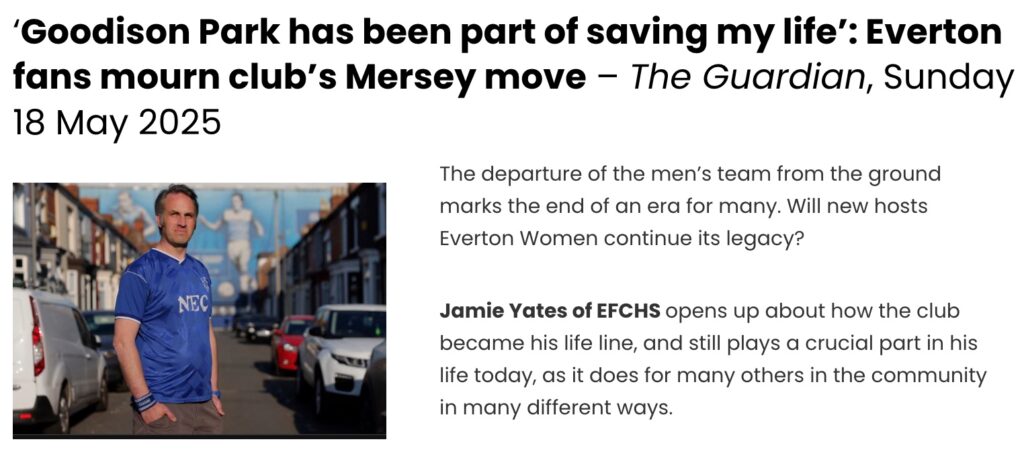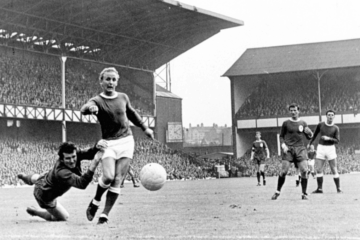Jamie Yates
The build-up to Everton’s departure from Goodison Park, their home of 133 years in the summer of 2025, triggered a range of emotions and set the members of the Everton Football Club Heritage Society (EFCHS) off on various quests to delve deeper into the history of the old stadium, to commemorate records set there, celebrate watershed moments and hopefully unearth a few hidden historical gems along the way. Recent seasons have been turbulent, even by Everton standards, and I have taken huge solace in burying myself in the stories of some of the key moments and early heroes of the pre-Goodison era for much of the past few years, occasionally emerging cautiously from the archives on a matchday to make sure the modern-day team are managing to scrape by.
One of the early Evertonian of note to whom I was drawn in particular was George Fleming, an enigmatic character like so many of his time, in that not much exists in writing about him, beyond the fact that he scored the very first goals for Everton in the opening match of the first Football League season in September 1888. A handful of appearances later and he was gone. The only biographical detail of note I could find on Fleming was a piece written by my EFCHS colleague Tony Onslow entitled ‘The Goalscoring Bank Clerk From Arbroath’ which was originally published on the Society website some time ago. I had also stumbled upon George Fleming’s grave at Anfield Cemetery in 2020, the headstone regrettably in a sorry state of repair, and hoped that his might be one we could add to our ‘to do’ list for a future headstone replacement and rededication project.
I began to delve a little deeper into the story of George Fleming’s life, his family tree, achievements prior to his arrival at Everton, and in later life. I was incredibly fortunate to trace and contact one of Fleming’s grandsons, Alastair Fleming, born and raised in Liverpool and alive and well at 87 years of age. By remarkable coincidence Mr. Fleming now lives on one of a small group of islands off the west coast of Scotland where I lived for a period before moving back to Liverpool in 2018. In July 2025, I had the pleasure of visiting him in person and comparing notes on his grandfather’s life and footballing exploits when I went to collect my daughter for her summer holidays. By further coincidence, Tony Onslow also has a family connection to the same group of islands.
It seems the three of us were destined to connect at some point to tell the full story of one of Everton Football Club’s early heroes.
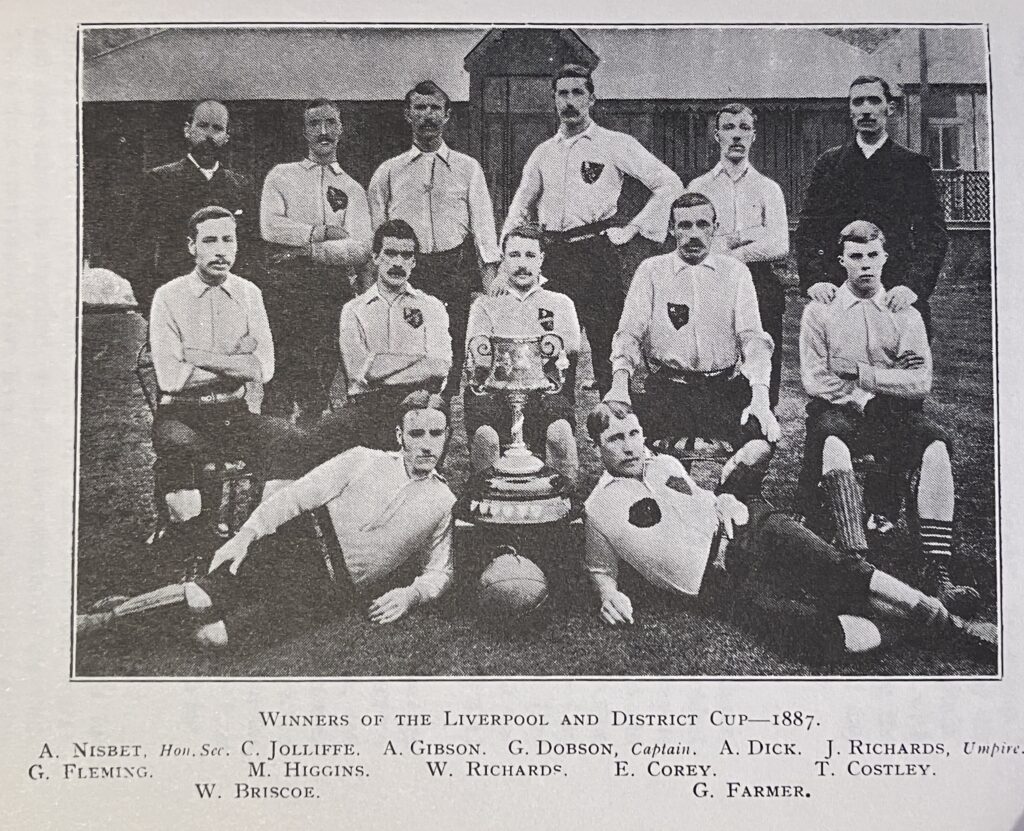
Early Life & Family
Along with twin sister Jemima, George Spink Fleming was born on 4 November 1864 in the Forfarshire (now Angus) harbour town of Arbroath, where their parents David Fleming and Elizabeth Spink were married on Christmas Eve of 1855. David Fleming ran a grocery store at No.72 (later 80) Marketgate in Arbroath, and the Fleming family were resident there at the taking of the 1881 census. George, then aged sixteen, was working as an apprentice bank clerk at the branch of the British Linen Co. Bank at Brothock Bridge in the town centre, just a short walk from the Fleming family home, while also making a name for himself as a footballer for the leading club in the area.
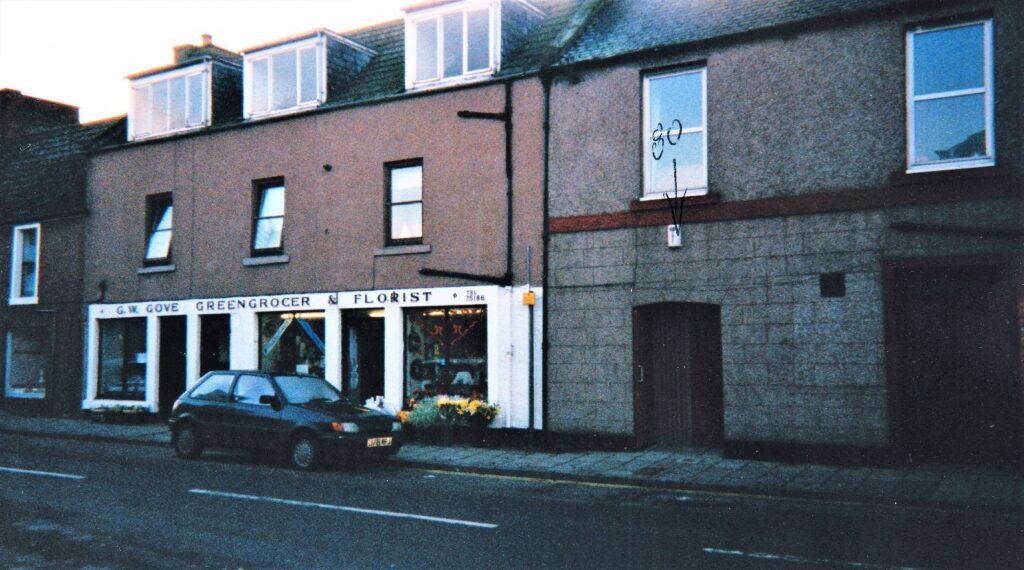
In addition to twins George Spink and Jemima Sym, David and Elizabeth had six more children; Catherine Spink, David, Elizabeth, Charles and Mary Spink prior to the twins’ birth in 1864, plus youngest son William, who was born in 1866. The following information is taken from the files of Alastair Fleming, grandson of George:
‘Tragedy struck in 1870 when both William and Charles died within three days of each other of scarlet fever, a disease easily treated with antibiotics these days.
‘The grocery store was clearly successful and traded not just locally but, in the early 1850s, sent goods to the Shetlands. What part George played in the shop, we don’t know, but it is clear that his eldest brother David was being trained for succession. Unfortunately, David died in 1883, and the business did not survive into the next generation, as George was already making his own way in life.’
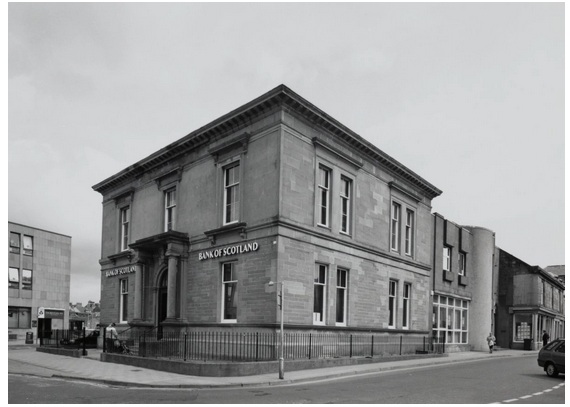
Local Hero
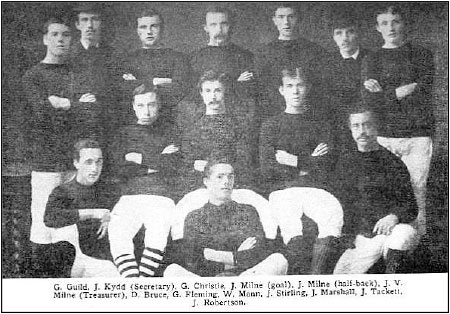
The above photograph, taken in 1882, shows the Arbroath football team in their recently acquired maroon shirts. George Fleming is clearly depicted sitting in the middle row. In early local press reports, Fleming was referred to by the nickname ‘Joe’ and this name also appeared in a detailed obituary published in the Arbroath Herald after Fleming’s passing in 1912. The same article stated that Fleming had begun playing football on High Common for Arbroath High School.’ (Alastair Fleming)
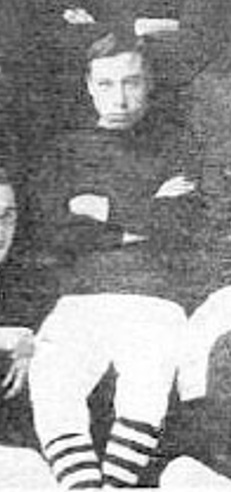
Arbroath Football Club was formed in the summer of 1878, at the very same time as the young men of the Church of St. Domingo, 320 miles away in Everton, were rustling up a football team. George Fleming would have been just thirteen years of age at this point. However, it would not be long before his own footballing ability would catch the eye of local talent scouts.
The first recorded appearance of ‘Joe’ Fleming in the Arbroath FC first team was for a match at Dundee Harp on 17 September 1881. Fleming was still two months short of his seventeenth birthday when he played in the 1-1 draw at East Dock Street. His first recorded goal for the club came in a 4-0 thrashing of Strathmore (Dundee) at Gayfield on 4 February 1882. He featured in several more matches that season and nailed down a regular spot in the team during the 1882/83 season.
From the Arbroath Herald obituary published 12 April 1912:
‘It was John Devlin, Arbroath’s full-back – now governor of Dunfermline Poorhouse – who first spotted Fleming. The latter was playing for the old High School team at the time on the High Common… in 1882-83, the first year of the Forfarshire Association, Arbroath and Harp faced each other in the final at Rollo’s Pier, the ground of the long defunct Strathmore. The field was a perfect quagmire, and in several places flooded. On that day Joe played one of his best games and was the hero of the match, and the admired of all admirers when we brought home the cup – winning by 2-1.
The next important game which memory still brings clearly before me was also a cup tie in 1884-85, with the then and still famous Glasgow Rangers… the first half ended by our being three down. That second half will be in the memory of many “Red Lichties” to this day. Our supporters from the depths of despair were raised to a pinnacle of exuberant joy. We put on four goals and drew the tie out of the fire. “Good old Joe!” was the unanimous shriek of our supporters, and well he deserved it all. Joe did his duty right manfully, and it was to him to a very appreciable extent that victory was ours that day.’ Arbroath Herald, 12 April 1912
In the same piece, Fleming’s old Arbroath teammate on the right-wing, John ‘Jake’ Tackett, recalled the early days of their friendship:
‘Joe and I were schoolboys together… My first football companionship with him was in 1878, when we were spectators at a match between St. Clement’s and an Arbroath Select, played on the Low Common. It was at his request (through Willie Mann, the then captain of Arbroath’s team) that I joined, Joe having been in the ranks of the team a year previous to this. In season 1881-82 I have vivid recollections of the game v. East End, Dundee, a Scottish Cup-tie, in which we stood three goals down at half-time, and on retiring to the pavilion our captain made the cheering remark, “The case is nae hopeless yet, laddies, stick in an’ we’ll win.”
Joe and I made for our positions on the field to begin the second half, and rolling up the sleeves of his jersey above the elbows, he said to me, with dogged determination in his firm, broad jaw, “By golly, Jake, we’ll make them toddle this half.” And we did, the whole team seemed to become infected with Joe’s resolve, and a sensational game ended in our favour by 4 to 3, of which, if I remember rightly, Joe had two to his credit.’
Another close friend of Fleming’s, a plumber by the name of David Cook also shared his personal memories:
‘He remembers well Mr. Devlin going across to Fleming on the High Common and remarking: “I want a man to play for Arbroath; will you come?”
Mr. Cook said: “Picture the man; a mere stripling of a lad with his Balmoral bonnet and the ribbons hanging down his back. But he was a footballer – every inch of him – and he played so well the first time for Arbroath that he was never out of the team.
David Cook also recalled an occasion when Fleming had stepped in to assist the great Queen’s Park club in a match with Dundee club, Strathmore, when the famous Glasgow side arrived for a friendly a man short. Fleming was playing in a match for Arbroath on the ground of another Dundee club, Our Boys, when Charlie Campbell, the Queen’s Park captain, approached Arbroath club secretary Davie Duncan and asked whether he would be willing to lend him a player:
‘Mr. Duncan espied Mr. Cook walking round the enclosure carrying Fleming’s clothes – for Joe rarely entered a stripping house – and, relieving him of his burden, asked Mr. Cook to approach Fleming on the field. The player was only too willing to oblige the Queen’s.
At the close of the (Arbroath) match, a two-horse vehicle was in readiness to convey Fleming and his companion to Rollo’s Pier, and by the time the park was reached the Arbroath jersey had been substituted for a Q.P. one.
Alighting from the carriage, Fleming entered the arena, and thinking he was some great player who had arrived late in the city, the spectators loudly cheered him. Fleming had not been long on the field when he scored two brilliant goals from the touchline. The renowned “Wattie” Arnott stepped over to the Arbroathian and, shaking him by the hand, remarked: “By Jove, my lad, you have taken us out of a hole today.”’
NB. It seems likely that Mr. Cook was slightly confusing his memory in respect of the team which George Fleming stepped in to help out in this instance. I can find no record of Fleming turning out for Queen’s Park versus Strathmore at Rollo’s Pier; he did however bolster the Strathmore team versus I Zingari (a combination team of the top players from the leading Glasgow clubs) there on 9 June 1883, a match in which Charlie Campbell of Queen’s Park appeared. The Glasgow side won the match by two goals to one, but a Strathmore XI strengthened by several guest players performed creditably:
‘Knowing well that the combination they had to contend against was more than they were able to keep in check, they secure the service of five first-class players, namely Kennedy (goalkeeper), of the East End; Falconer and Moncrieff (backs), of the 3rd L.R.V. (Glasgow); G. Lawrence (half back), of the Queen’s Park, and our rising county forward, Fleming, of the Arbroath.’
Dundee Courier, 12 June 1883
First Silverware
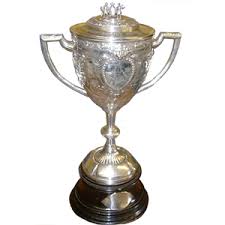
On the afternoon of Saturday, 22 December 1883 the inaugural final of the Forfarshire County Cup was held at Rollo’s Pier, the home of the Strathmore (Dundee) club. The Forfarshire Football Association (FA) had only formed in the early months of 1883 and Arbroath and Harp, another Dundee club, contested the final tie. George Fleming, who had scored in every round up until the final, lined up for Arbroath as a crowd of between 3,000-4,000 assembled. Funds raised from a series of friendly matches had been staged between the clubs which comprised the membership paid for the trophy, and each member of the winning side in the final was to be awarded a gold badge, with players of the losing team each awarded a silver one.
Arbroath had faced a tougher route to the final, facing Dundee clubs Our Boys, West End and Strathmore, while Harp had defeated Broughty Ferry, Clydesdale and the Strathmore (Arbroath) club. Harp and Arbroath had already fought out a draw at Arbroath earlier in the year, while Harp had triumphed by two goals to one in the return fixture at their own Viewforth Park ground in front of a crowd of up to 5,000, the biggest turnout on record for an association football match in the region up to that point.
The Dundee Advertiser published on Christmas Day 1883 reported on the cup final:
‘Great interest had been manifested in the different matches in the earlier stages of the competition, and this reached its crowning point on Saturday, when the deciding tie was begun amidst the liveliest excitement and expectancy. Both teams were known to be in capital condition, and a stubborn contest was predicted on all hands, opinion being about equally divided in favour of the Clubs.’
The report went on to describe weather conditions as ‘wretched,’ heavy rain falling throughout the day, settling into a ‘drenching rainstorm… the ground was completely flooded… the match was more a trial of the stamina of the players than a test of their skill.’ Nevertheless, kick off took place on time at two o’clock, the referee having ‘placed, or rather floated the ball in the centre of the field.’
George Fleming was soon in the thick of the action, exchanging passes with his right-wing partner Jake Tackett and creating Arbroath’s first chance which went begging. Fleming was not to be denied, however: ‘Fleming then got hold of the leather, and by a smart run and judicious passing with Tacket, managed to carry the ball within a yard of the Harp’s goal line, where he passed smartly across the field to Robertson, who, finding the desired opening, sent the globe spinning between the posts amidst applause.’
In response, Harp created a succession of chances but, by a combination of misfortune and inaccurate shooting, failed to find the target, before controversy erupted. In extraordinary scenes, the Harp players claimed that an Arbroath spectator standing close to his team’s goal had stuck out a foot and diverted a goal-bound shot safely into the hands of Milne, the Arbroath goalkeeper who had then tossed the ball out of play. The referee agreed with the Harp protest and awarded a goal, levelling the score. Just before half-time, Fleming and Tacket again combined, Fleming crossing to Mann who drove the ball home to restore his side’s one goal advantage at the interval.
With the quagmire of a pitch sapping the energy of both teams and virtually every man caked head to foot in mud, try as they might, the second half appears to have descended into something of a farce. This was compounded with only five minutes remaining when a spectator appears to have blown a whistle in the crowd, the Arbroath contingent erupted in cheering and both teams, doubtless relieved as much as anything, trudged off, only to find the referee chasing them into the dressing room to demand they troop back out to finish the match under his jurisdiction and not that of the errant whistle-blower. However, several of the Arbroath players refused to return to the field of play and Harp immediately lodged a protest. As a result, the cup and badges for each team were not presented at the immediate post-match gathering at the Queen’s Hotel in Dundee. A meeting of the committee of the Forfarshire FA was swiftly convened.
The Arbroath team took the train back home where a horse-drawn wagonette accompanied by the band of the local Rifle Volunteers playing ‘See the conquering hero comes’ greeted them and they were escorted through the town; the streets lined with a crowd of jubilant locals. By the time the players had finally managed to find sanctuary at the Royal Hotel, a telegram came through from the Forfarshire FA committee, confirming that, by a majority of six votes to four, Arbroath had been confirmed as winners of the match and champions of the cup. Goalkeeper Milne flung open a window and read the news to the crowds still gathered below in the street outside, to a renewed burst of cheering and celebration.
Further Thrills & Spills
Fleming continued to score goals and delight the Arbroath spectators with his dashing runs, accurate crossing and powerful shots, and it was no surprise when, in February 1884, he was selected by the Forfarshire FA to partake in a ‘probables versus improbables’ match, from which players would be chosen to represent Forfar versus Fife in an inter-county fixture. Chosen as a member of the ‘improbables’ XI, Fleming clearly impressed, as he made the cut alongside four of his Arbroath teammates. The match took place on 29 March 1884 on the ground of the Our Boys club in Dundee, before an estimated crowd of between 2,000-3,000.
The Dundee Courier of 31 March 1884 report stated that Forfar started brightly and took an early lead through Donaldson. Shortly thereafter, ‘a hard shot by Fleming rebounded from one of the goal posts back into play.’ The ball was immediately sent back into the danger area and Mann rifled home a second goal for Forfar only to see it ruled out for offside. Five minutes later Forfar doubled their lead with a legitimate goal this time from McLean. Fife then managed to get a foothold in the game, controlling the play for a period until ‘Fleming got away, and after running almost the entire length of the field, centred the ball, which Whitton headed just past the side of the post.’ McLean added a third goal before once more ‘Whitton broke away, and on getting to the north end passed to Fleming, who sent in a shot, which scarcely required the additional powder given it by McLean, and the Fife colours were lowered for a fourth time.’ Plucky Fife kept at it, but by half-time Moor had seen another goal for Forfar disallowed for offside and McLean had registered his fourth, and Forfar’s fifth, goal of the match. Only one more goal was scored in the second half, when, on 70 minutes, George Fleming’s hard work was rewarded as he rounded off a 6-0 victory for his county.
‘McLean owed not a little of his success at goal to the very generous play of Fleming… After the match both teams adjourned to the Queen’s Hotel, where they sat down to an excellent and substantial tea, presided over by Mr. W. E. Buchan, vice-president of the Forfarshire Association.’
All was going well for George Fleming on the football pitch, before disaster appeared to strike, as reported in the Arbroath Guide issue of 17 May 1884:
‘Arbroath v Strathmore: These teams met on Saturday last at Gayfield to play a match in aid of the Infirmary… Three minutes from the start Fleming, the right wing forward, had to retire owing to getting his right arm dislocated… The game ended in favour of Arbroath by one goal to nil… We are glad to add that the injury to Mr. Fleming has proved not to be so serious as was at first supposed, and that he is now about all right again.’
It later transpired that Fleming had, in fact, broken his collar bone in a collision with Stormont, the Strathmore goalkeeper. Fortunately, he made a full recovery and was fit and ready to compete in a number of memorable matches during the 1884-85 season.Saturday, 1 November 1884 saw Arbroath face Harp, at Gayfield, in the semi-final of the Forfarshire Cup, a re-run of the previous season’s final. Arbroath opened the scoring before Harp equalised and, in double-quick time, took a 2-1 lead. Shaken, the Arbroath team gradually found their feet and won a corner, in the aftermath of which a foul took place within striking distance of the Harp goal. As the Dundee Courier reported: ‘from the free-kick Fleming caught the ball, and with lightning-like rapidity sent it through amidst deafening cheers.’ The match finished 2-2 and a replay was ordered at East Dock Street Park, the home of Harp, the following Saturday.
A week later, a crowd of around 8,000 assembled in wet and windy conditions, the ground heavy from a torrential downpour that morning. Within 15 minutes, Harp were two goals to the good. Arbroath rearranged their tactics at this point, this reshuffle including George Fleming who had been playing at centre-forward, moving out to the right-wing. The play became very much end-to-end, with further chances squandered by both teams, before a long-range shot by Mulvey for Harp went in off the post to give the home side a 3-0 advantage at half-time. Arbroath refused to give in, however, and within minutes of the restart had pulled a goal back through what the Dundee Courier report described as a ‘beautiful shot’ by Tackett. Growing in confidence, Arbroath continued to pepper the Harp goal and, on 52 minutes, when goalkeeper McTaggart spilled a swerving shot from Milne, Fleming was on hand to tap home the loose ball and make the score 3-2. Again, Harp hit back, coming close on two occasions. ‘The Arbroath, however, could not be longer denied, and after a brilliant run, in which all opposition availed nothing, Fleming made the scores level. The result was now an open question, and intense excitement prevailed.’
Alas, Arbroath’s luck finally ran out, and, despite their exertions, Harp scored twice in the closing stages to round off a thrilling game with a 5-3 victory.
A relentless run of testing fixtures continued seven days hence, when, on 15 November 1884, Arbroath welcomed Glasgow Rangers to Gayfield in the fourth round of the Scottish Cup. From the outset, the team from Govan tore into their opponents and, after just 25 minutes, had built up a 3-0 lead, this despite having played a man down after full-back Young had hobbled off just fifteen minutes into the match with a leg injury. Marshall then pulled a goal back for Arbroath, and Fleming, shortly before the break and ‘by a long kick’ according to the Dundee Courier match report, made the score 3-2. Arbroath made an attacking tactical alteration at the interval, switching from two half-backs to three, and Rangers began to struggle. Courtesy of Crawford, Arbroath drew level, and, after 65 minutes, amid scenes of tremendous joy, took a 4-3 lead from a header by Robertson which they held until the final whistle.
At the close of the game, the Rangers players and officials took exception to the width of the Gayfield pitch, alleging that it did not meet the required dimensions. After taking measurements, Rangers lodged an official protest, which was rejected twice by the Scottish FA. Undeterred, Rangers appealed for a third time, and, a month later, their case was heard once more.
Dundee Evening Telegraph, 17 December 1884:
‘A letter was read from the Rangers requesting that their protest against Arbroath’s ground to be reconsidered. It was agreed by 10 votes to 8 to reopen the matter. After hearing the evidence again regarding the width of the Arbroath ground, the Committee concluded the Rangers had proved their case and ordered the match to be played over again on Saturday first on any ground the Arbroath may select. The decision was arrived at by 9 votes to 7.’
An extraordinarily frank review of this sudden about-turn by the Scottish FA appeared in the ‘Football Notes’ column in the same issue:
‘The Scottish Association on Tuesday performed a complete somersault in the matter of the Rangers’ protest against the Arbroath’s ground, to the great admiration, I have no doubt, of the devotees of the dribbling game in Glasgow. The Committee, after twice holding the word of promise to the Arbroath’s ear, have at the eleventh hour broken it to their hope, to gratify a popular clamour in Glasgow, the inhabitants of which city had become alarmed at the slender chance that, with the Rangers retired, would remain of their retaining the Scottish Cup. The merits of the protest are too well known to need repetition here, but this much might be said, that, after twice dismissing the Rangers’ protest, and then upholding it, the Scottish Association have established a dangerous precedent, and earned a reputation for inconsistency which will be laughed at in most places outside the charmed boundary of the important city that is always desiring to be let flourishing.
The result of Tuesday’s decision Is that the Arbroath will have to fight their battle over again with the Rangers, who will thus have the opportunity of retrieving their defeat and again entering the Scottish ties. The match will take place at Gayfield, Arbroath, tomorrow, and I am sure the sympathies of a vast majority of genuine lovers of the game will follow the maroon jerseys in their second struggle to prove to the country that first-class football can be played outside of Glasgow, a fact which the more bigoted of the supporters of the light blues would seem to doubt. Should the Rangers win, which is quite probable, they will be welcome to their second-hand victory; but I scarcely think the laurels will become them in the eyes of a very large portion of the football public.’
Arbroath in turn appealed the decision to replay the match, but to no avail.
The Dundee Courier reported on the match, which was replayed on 20 December 1884, noting that the Rangers team was ‘received with groans and other marks of disapprobation’ but won the game at a canter, by eight goals to one. George Fleming was credited with an assist for the Arbroath goal, which was scored by David Crawford. The report concluded by stating that ‘the Rangers may be said to have played the match under a fire of unceasing groans and hooting. This was ungenerously continued up till they were seated in the train, and as it steamed out of the station a final volley of groans were given by a large crowd of home sympathisers.’
Rangers would exit the competition in the next round, beaten 5-3 by a Renton side including future Evertonians Andrew Hannah and Bob Kelso. Renton would go on to beat Vale off Leven in a replayed final at Hampden Park.
Liverpool Calling
In early January of 1885, Fleming was once again selected to represent the Forfarshire Association in the annual fixture versus Fifeshire, which was scheduled to take place at the ground of Dunfermline FC on 21 February 1885. However, a paragraph in the sporting column of the Dundee Evening Telegraph of 3 February 1885 cast doubt over Fleming’s ability to participate in the match:
‘The Arbroath, I hear, have lost their right wing, Fleming having accepted a situation in Liverpool. His place will not be easily filled. He was without doubt one of the best right-wing players in the county, and a man always to be relied on. His departure will necessitate the filling up of his place from the reserves in the forthcoming inter-county match with Fife.’
Fleming’s last recorded appearance for Arbroath was in a 3-6 home defeat versus the mighty Renton side at Gayfield on 2 January 1885.
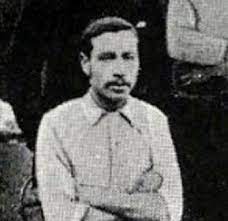
And so, aged only 20, George Fleming left Arbroath and travelled over 320 miles south to Liverpool. Upon arrival, he lodged with a marine engineer by the name of John Forcer Douglas and his wife Mary Elizabeth (nee Gordon). George took a job at the Bank of Liverpool (which was taken over by Martin’s Bank in 1919, and, in turn, by Midland Bank, which later became HSBC), and would spend the rest of his working life with the company. There is a good chance that Fleming may have worked for at least some of his banking career at the branch which still stands at the northeast corner of the junction of Spellow Lane, Walton Road and County Road, across the road from the Royal Oak public house.
Interestingly, in the afore-referenced Arbroath Herald obituary, no mention is made of Fleming’s four seasons playing for Everton, the trophies he won nor the historic first Football League goals he scored for the club. The only mentions of the fact he made the move south are as follows:
‘1884-85… was Fleming’s last season with Arbroath, for he left for Bootle and played once or twice for that club.’
Muddling his dates by a year, Fleming’s old teammate Jake Tackett states in the article that ‘Joe went to Liverpool in 1886… I have been in close communication with him all along…’
No records appear to exist of George Fleming ever having played for Bootle (or later Gorton Villa as has been claimed elsewhere). Nonetheless, records do confirm once and for all that, within a few months of settling in Liverpool, George Spink Fleming became a player for Everton Football Club.
1885/86 Season
Fleming made his Everton debut on 22 August 1885 against Darwen at Anfield and scored his first goal for the club on 19 September 1885 in a 2-3 home defeat against Accrington. Perhaps he made a mental note that afternoon, as two years later the brace he scored against the same opposition would earn him a permanent place in the Everton Football Club record books. A week prior to Fleming opening his Everton account, his old club Arbroath had caused a sensation in the football columns by defeating Bon Accord by a record 36 goals to nil in a Scottish Cup first round tie, a result which to this day stands as the largest margin of victory in an officially recognised professional football match.
Spectator, a columnist for the Liverpool Mercury, wrote in the edition of 21 September 1885:
‘An organisation having few equals for enterprise is the Everton, and the ex-cup holders have every cause to feel gratified at the position and the results attained by the team in the exhibition games already played; few clubs have made such immense strides as the club in question. The players acquired from other parts of the country are an undoubted success, making the combination the powerful one it is, though a weak spot or two might be filled up to advantage. Farmer, Wilding, Dobson, and Fleming are individually clever players; and when the eleven is thoroughly organised, it will be on an equal footing to others of first-class distinction.’
Fleming was in and out of the Everton first team until March, from which point he cemented a more regular starting position at either inside or outside right in a five-man forward line. On 10 April 1886, he picked up his first silverware in an Everton shirt, as a goal from Welsh striker Job Wilding saw Everton achieve a 1-0 win over fierce local rivals Bootle, in the final of the Liverpool Senior Cup which took place at Walton Stiles, the home of Stanley Football Club.
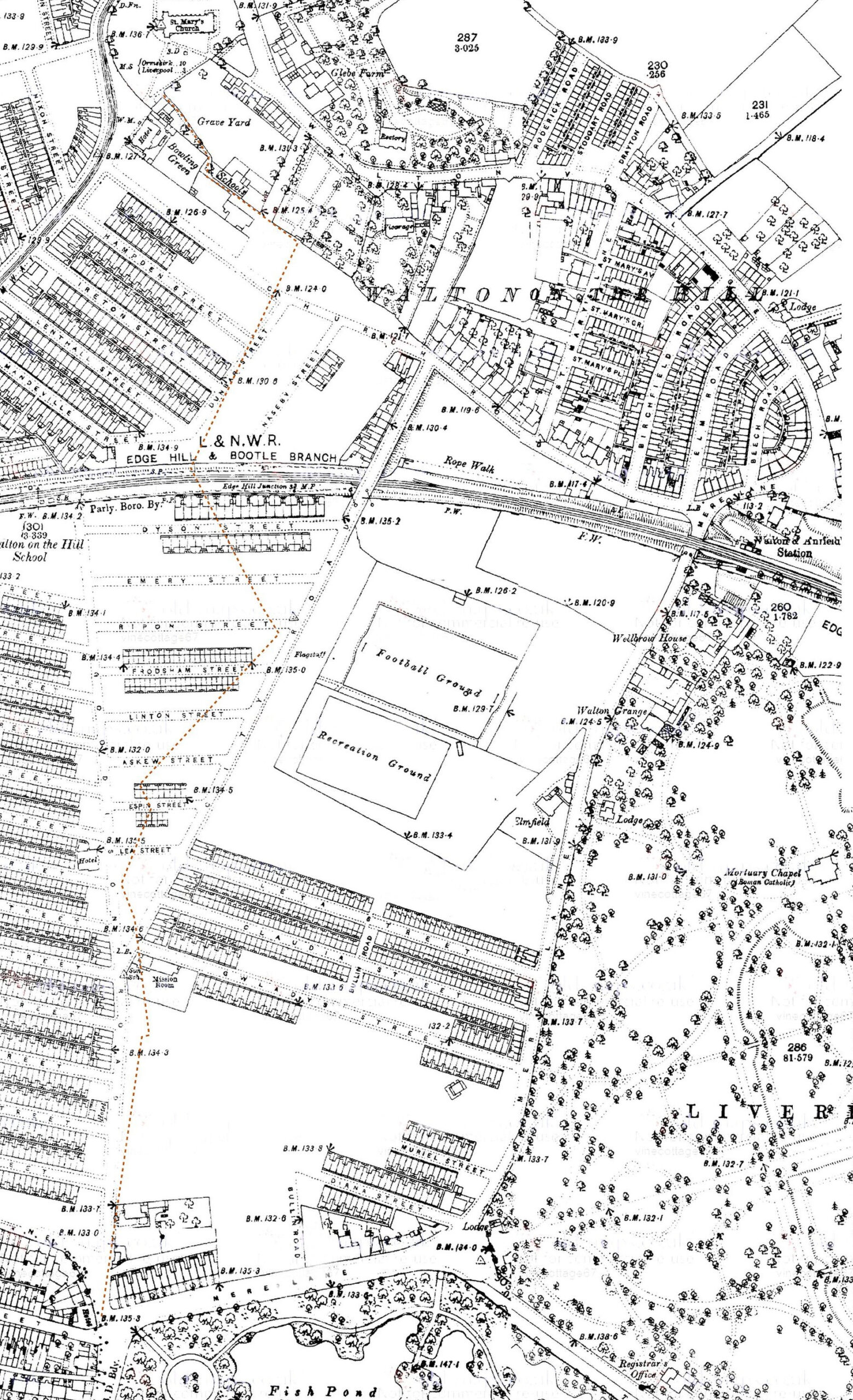
Bootle again provided the opposition in the final of the Liverpool Athletic Shield, at Liverpool Athletic Club on Prescot Road in Fairfield on 31 May 1886. A 2-1 win for Everton, with goals from Wilding and George Farmer, saw the men from Anfield achieve a double over their neighbours. George Fleming’s first season with Everton saw him score a creditable eight goals in 24 games in friendlies and local cup competitions.
1886/87 Season
7 August 1886 saw Everton open their campaign against Lancashire club Rawtenstall at Anfield, with George Fleming again among the goal scorers in a 3-4 defeat. Everton made an inauspicious start, losing their first three fixtures, but their form would pick up markedly as the season progressed. Fleming took part in the famous Liverpool Senior Cup tie away at Bootle on 23 October 1886, where the first attendance in excess of five figures at an Association Football match on Merseyside was recorded, with over 10,000 supporters present at Hawthorne Road for the big local derby, which Everton won 2-0. A week later, Fleming was part of the Everton team selected to face his old foe Glasgow Rangers. The match was originally drawn as an FA Cup tie, with Scottish teams at this point admitted to the English competition, but Everton scratched the tie to allow their ineligible players (namely a group of Scottish players who did not yet meet the criteria of having lived and worked for two years within the boundaries of the Lancashire FA and/or were not registered as professionals with the English FA) to take part and gain valuable experience playing against a top side. The Everton team performed creditably in a 0-1 defeat against the men from Ibrox.
On 2 April 1887, Fleming scored twice in a 5-0 romp at Hawthorne Road, Bootle, as Everton retained the Liverpool Senior Cup with victory over Oakfield Rovers. He scored 21 goals in 35 appearances in total that season, including his first Everton hat-trick in a 7-0 revenge thrashing of Rawtenstall in January, but only finished third top in the Everton goalscoring charts behind teammates George Farmer and Billy Briscoe, as an ever-improving Everton team netted freely and began to make a name for themselves in the football columns of newspapers up and down the country.
1887/88 Season
Everton finally made their FA Cup debut during the 1887/88 campaign. Throughout October and November, George Fleming took part in one instalment of the four-game marathon tie against Bolton Wanderers, retiring early from the third game of the series with a shoulder injury. Everton eventually found themselves expelled from the competition for unlawfully fielding several ineligible players, and were suspended from participating in it for the following season. They were also kicked out of the Liverpool Senior Cup and had the previous season’s title stripped from them, in an unprecedentedly wide-ranging punishment from both local and national associations.
In what understandably became a rather disjointed season for the club, punctuated by a few high-scoring victories and a strong finish, Fleming remained prolific, scoring 18 goals in 26 appearances, including a second hat-trick in a 9-0 home win over Bury, a club-record at the time of scoring in seven successive games through February and March, and a remarkable six goals in a 10-1 away victory at Irish club Cliftonville on 16 April 1888. Although still very much an amateur, the club retained his registration, meaning he would be a member of the Everton squad as they prepared for the groundbreaking commencement of the Football League in September 1888.
George Fleming’s Everton career record in the pre-Football League era stands at an impressive 47 goals from 84 appearances, placing him third, behind early club icons Jack McGill and George Farmer, in the club’s goalscoring stakes and tenth in overall appearances made up to this point.
1888/89 Season
Everton’s first match in the first season of the Football League took place at Anfield on Saturday, 8 September 1888. The visitors were Lancashire club Accrington, a predecessor of the famous Accrington Stanley club.
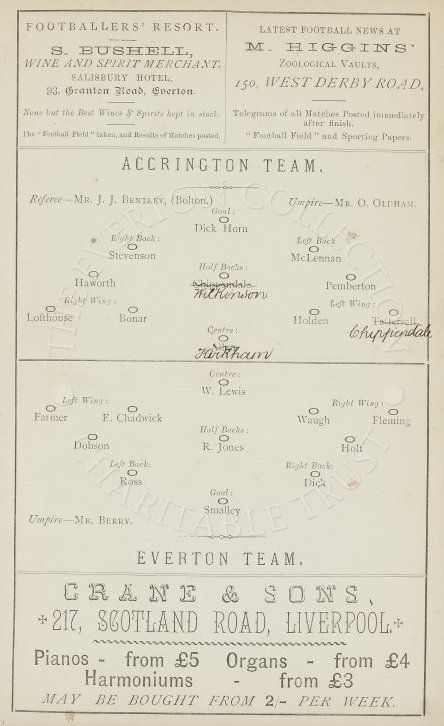
In front of the largest crowd* in the country on a monumental day in English football history, George Fleming took up his favoured position on the right of the home forward line. Fifteen minutes into the second half, with the game still goalless, George Farmer crossed the ball to Fleming who headed himself into the record books by scoring the first goal for Everton Football Club in a Football League match. He then added a second, again created by Farmer, as Everton emerged victorious by two goals to one.
*various match reports estimate the total attendance at anywhere between 8,000 and 12,000.
The following is an excerpt from the match report which appeared in the Liverpool Mercury on 10 September 1888:
‘Lofthouse was stopped in a run by Dobson, who gave the pass to Waugh, who in turn gave to Farmer, and that player enabled Fleming to head the first goal. Striving hard to equalise, Bonar and Lofthouse were held in check by Holt, but the visitors still kept in the home quarters, and Dick was the hero of the finest bit of back play seen on the Everton ground for some considerable time, keeping his lines clear in grand style.
Resuming, Everton again became aggressive, and Fleming soon registered a second goal from a pass by Farmer… Accrington next had the best of the play, and, after Holden had headed onto the bar and Kirkham had hard lines, a free kick was conceded, from which Holden beat Smalley. Everton then had another try to score, after which Holden severely tested the home custodian, but without effect, a strongly contested game thus ending with the result Everton two goals; Accrington one.
Teams; Everton:- Smalley, goal, Dick and Ross (captain), backs, Holt. Jones (R), and Dobson, half-backs, Fleming, Waugh, Lewis (W), Chadwick, and Farmer forwards. Umpire: Berry (E). Accrington:- Horne, goal, Stewart, and McLennan backs, Haworth, Wilkinson, and Pemberton, half-backs, Lofthouse, Bonar, Kirkham (E), Holden and Chippendale forwards. Umpire: Oldham (O). Referee J.J. Bentley.’
George Fleming made only three more appearances for Everton, in the second game of the season, a 2-1 home win over Notts County, and then successive away and home games against Burnley in November, which ended 2-2 and 3-2 respectively. One of the last mentions in the local press of Fleming appearing in an Everton XI was for the Lancashire Senior Cup semi-final tie versus Bootle in March 1889.
In an interesting sidenote, Fleming also served as a member of the Everton committee during his playing days and for some years thereafter, presumably making use of his professional skills in banking. There was precedent for this, as young striker Alex Provan, a trainee accountant, had also served on the Everton committee during his playing days in the earliest seasons of the club, while still only a teenager. ‘G. S. Fleming’ was listed as a member of the Everton committee on season ticket books for the 1887/88 season.
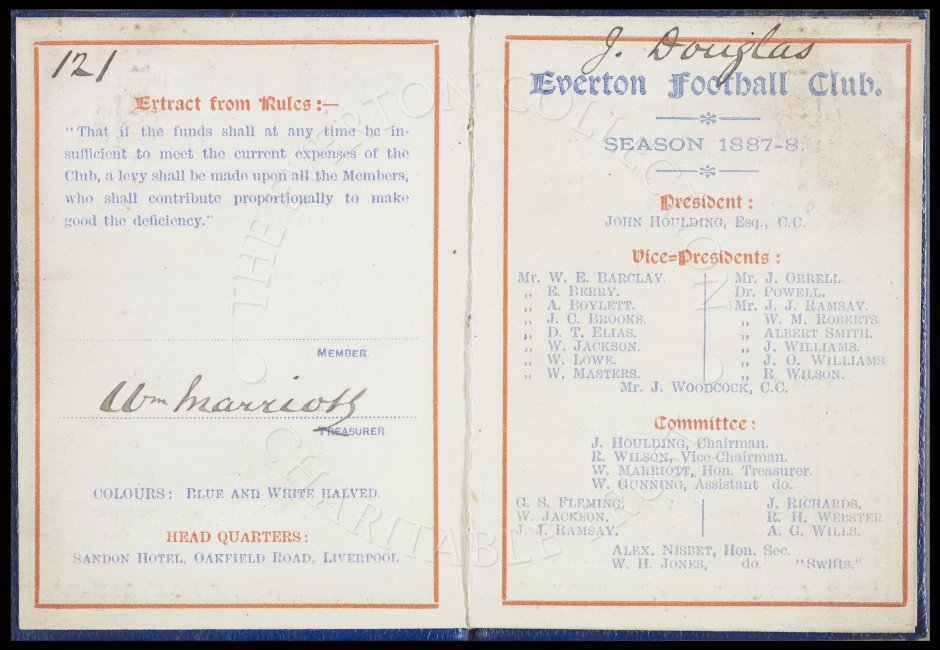
(The Everton Collection)
Fleming is listed regularly in minutes from meetings held from at least as early as October 1887 (the earliest club minutes still in existence today), prior to announcing his intention to step down from the committee, a decision which was met and recorded ‘with much regret’ in the minutes of the meeting of 25 May 1891. The minutes for the meeting of the Everton committee on 13 July 1891 read as follows:
‘Mr. G. Fleming – Resolved that a purse be purchased and engraved and that we present the same with £25 to Mr. G. Fleming at the next meeting.’
The next meeting took place on 27 July 1891, and the minutes (which were approved at a subsequent meeting on 10 August) recorded that the presentation was made to Fleming by club President John Houlding as planned:

‘Testimonial to G. Fleming and Mr. Wilson – The presentation to Mr. G. Fleming was made by the President and also that to Mr. Wilson.’ (The Everton Collection)
The following from the Liverpool Sporting Express was reprinted in the Arbroath Guide a few weeks later:
‘PRESENTATION – The golden opinions which Mr. George Fleming has won for himself during his long connection with the Everton club found audible expression at the committee meeting last Monday night, when Mr. John Houlding presented him with a well-filled purse of gold in recognition of his services. Mr. Fleming served the club first in the capacity of a player and afterwards as a committee-man, and general regret has been expressed in Everton that his removal to Seaforth necessitated the severance of his connection with the club. Mr. Fleming has always been an amateur of amateurs, and it is a noteworthy fact that the purse of gold presented to him last week contained the first money he had ever received for his services. (Mr. Fleming, who served his apprenticeship in the British Linen Co. Bank, Arbroath, is a son of the late Mr. Fleming, Brothock Bridge)’
Post-Football Life
As confirmed in the reporting of his resignation from the Everton committee, George Fleming remained an amateur throughout his time at Everton. There was no security in a career in professional football in Fleming’s era, nor would there be for many decades thereafter, and he called time on his playing days, aged just 24, to focus on his career with the Bank of Liverpool. He was employed as a bank clerk and still boarding with John and Mary Douglas at their home, 50 Thomaston Street in Kirkdale, as of the 1891 census return, where his name is mis-transcribed as ‘George S. Flemming’. Fleming’s relationship to the head of household on the census is listed as cousin (he was in fact a first cousin, once removed, of Mary Douglas on his mother’s side).
On 17 July 1900, at the Church of St. John in Waterloo, George Spink Fleming married Margaret Speirs Crawford, daughter of the late David Crawford, a successful Scottish-born marine engineer.

The wedding was reported in the Waterloo and Crosby Herald and copied in the Arbroath Herald and Advertiser as a lavish affair, attended by numerous family members and friends. An extensive list of gifts received by the couple was also published. The newlyweds later boarded a train to Edinburgh, on their way to honeymoon in the Trossachs and Northern Highlands.
Margaret was also the niece of George Fleming’s long-term landlord, John Forcer Douglas, whose younger sister Elizabeth married David Crawford in 1872 at St. Mary’s Church in Walton.
David Crawford and Company employed over 100 people at his foundry which faced onto Blackstone and Fulton Street in Vauxhall, directly opposite Bramley-Moore Dock. After David Crawford’s death in 1897, the company passed to his son, John Forcer Crawford, who shortly thereafter joined forces with fellow engineers William Bernard Railton and Richard Campbell, rebranding the business under the name Railton, Campbell and Crawford. The business relocated to the Washington Foundry on Cherry Lane in Walton. There, in the early years of the 20th century, the propellors for the Cunard liner RMS Mauretania and the ash hoists for the ill-fated White Star Line vessel RMS Titanic were forged.
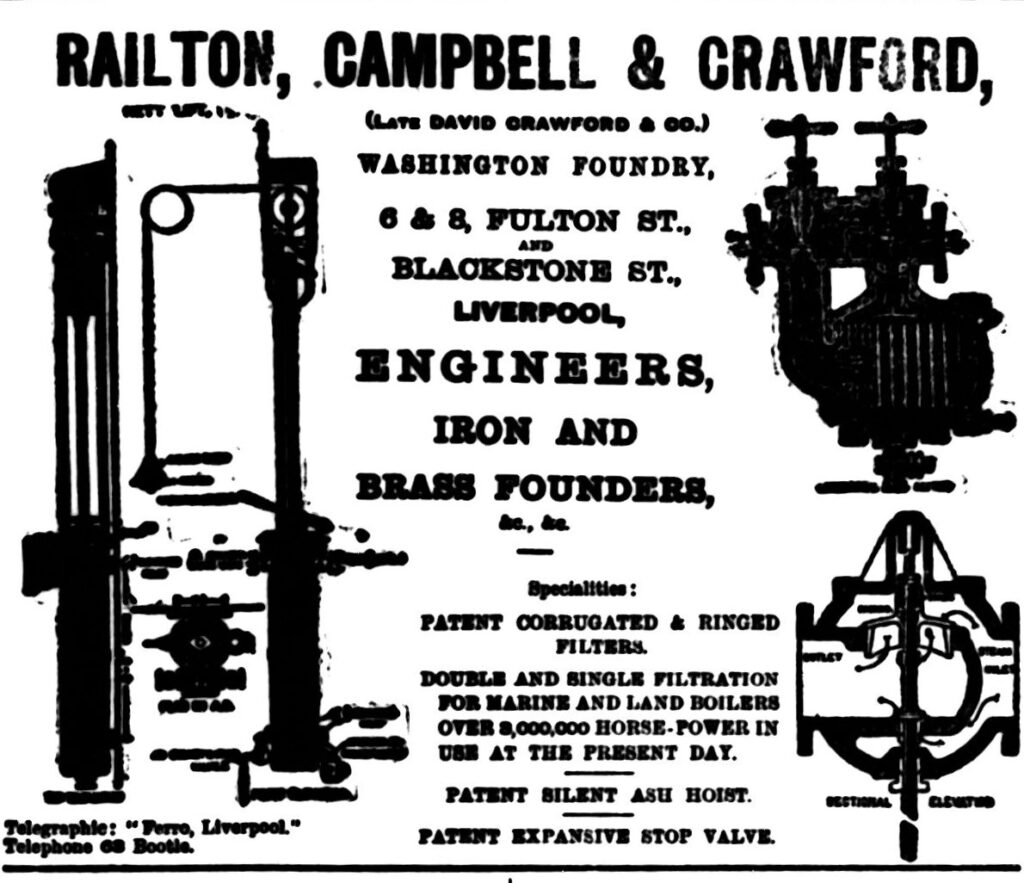
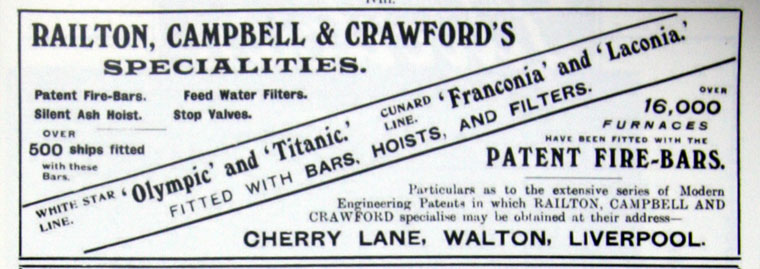
The 1901 census recorded George and Margaret Fleming living at 33 Cavendish Road, Crosby, along with their first child, a son they named David Crawford Fleming, born in 1901, and one servant. In 1905 the family moved to 59 Winstanley Road in Waterloo where a second son, Noel Douglas Fleming, was born in 1908. The family were still living at this address in 1911, and the census return reveals that John Forcer Douglas was also living with them. By now aged 73, John was retired and widowed, his wife Mary having passed away six years previously.
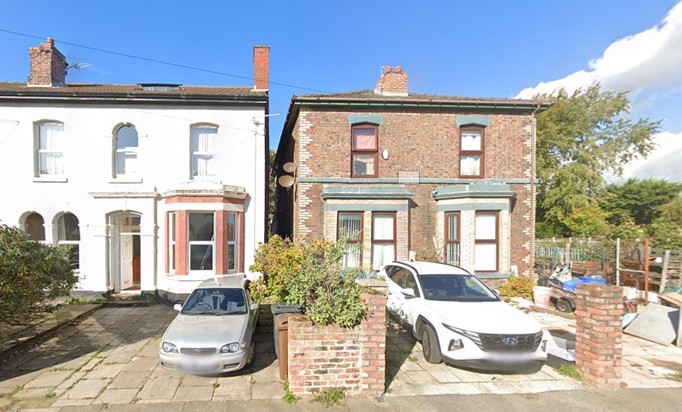
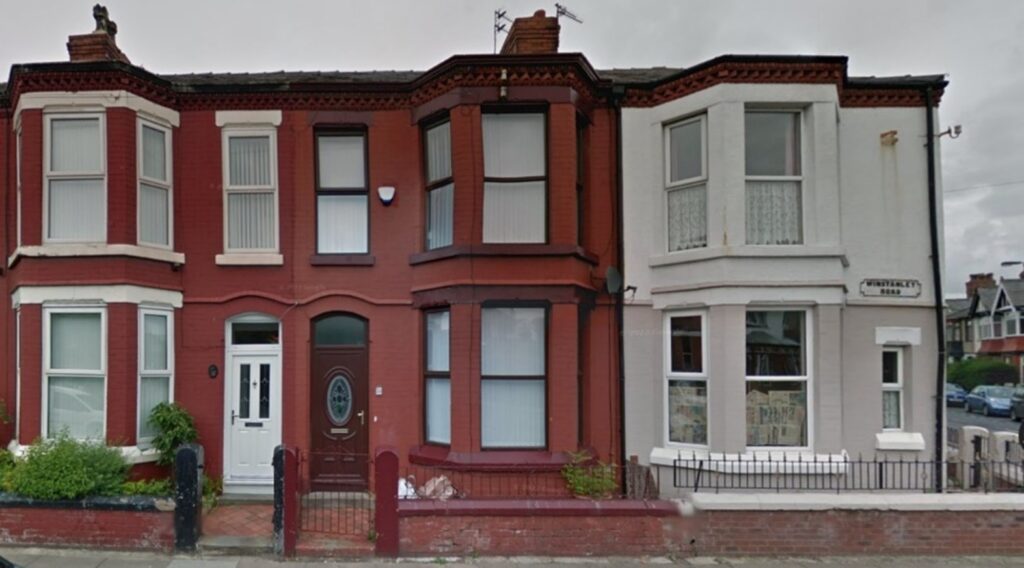
At some stage in the early years of his marriage, George Fleming was diagnosed with disseminated sclerosis (now known as multiple sclerosis). Sadly, his condition appears to have deteriorated quickly, and, after fighting the illness bravely for a decade or more, he died, aged just 47, on 1 April 1912, exactly a fortnight before the Titanic disaster shook the world. Fleming was buried at Anfield Cemetery on 4 April 1912, with a former Everton teammate, William J. ‘Billy’ Gibson, a near neighbour of the Fleming family in Waterloo, notable among a long list of mourners. His name was also inscribed on the family headstone at Western Cemetery in Arbroath, resting place of his parents and five of his seven siblings, including twin sister Jemima.
Obituaries were posted in the local press in in both Liverpool and Arbroath, including the following from the Waterloo and Crosby Herald:
‘I chronicle, with profound grief, the fact that George Fleming, the famous Everton outside right of the late ‘80’s, passed away yesterday at his home in Waterloo after an illness extending over 10 years. For some time past the deceased had been an invalid, fighting an insidious affliction with great pluck and determination, but it proved to be only delaying the inevitable. He will be recollected by followers of the club in their Anfield-Road days as a splendid winger, having any amount of pace, and his death severs another link in the chain of the boys of the old brigade. He came of an old Scotch family, hailing from Arbroath, and was one of the best of men. He was only 47 years of age and leaves a widow and two sons to mourn his loss.
‘So poor George Fleming has gone. Many a brilliant outside right game he played for Everton at Anfield Rd. The last time I spoke to him was in one of your old horse tramcars. He had been hurt whilst playing and was prevented from turning out for some time. I saw him later at Waterloo after he had gone to reside in that suburb, and it was then but too evident that those Alec Latta-like sprints along the touch line must have been painful recollections to him.’
The following appeared in the Scottish Referee:
‘George Fleming, one of Everton’s old heroes, passed away at home in Waterloo last week, after a lingering illness. The old front line is being gradually depleted, and Fleming has now followed George Farmer to his last long home. Fleming was one of the most gentlemanly and most earnest players, and, along with the tiny Briscoe, made a wing that was always respected by the enemy. He has succumbed to one of the most insidious attacks possible. Deceased was only 47 years of age.’
Margaret Fleming was buried with George when she passed in 1955, and the ashes of eldest son David and his wife were later interred at the plot. The headstone also commemorates youngest son Noel, who was killed in action in the Netherlands on active service with the Royal Air Force in April 1943. Noel, who attended Merchant Taylor School in Crosby where he excelled as an all-round athlete and rugby player in his youth, was buried at New Eastern Cemetery in Amsterdam and is also commemorated on the war memorial opposite St. Helen’s Church (Sefton Parish Church). The Douglas and Crawford family graves are situated in the same row as the Fleming plot in Church of England, section seven, at Anfield Cemetery.
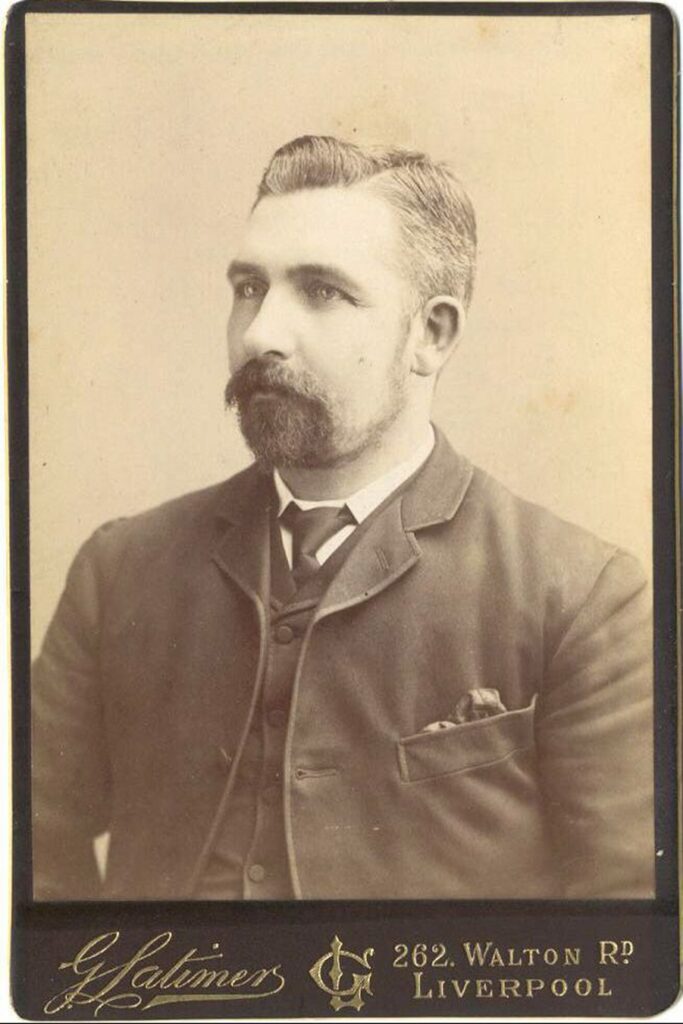
In May 2025 on a walk around Anfield Cemetery, EFCHS member Jamie Yates spotted the new headstone in position at the Fleming family plot. He managed to trace Alastair Fleming, grandson of George Fleming, alive and well on the west coast of Scotland. Mr. Fleming was generously forthcoming with the additional biographical information which supplements Tony Onslow’s original article, the picture of the original Fleming headstone before it was irreparably damaged and the new one in situ, and the above photograph of George Spink Fleming – previously unseen by Evertonians – in his post-football days.
262 Walton Road, the address of the photography studio printed on the border of the photograph, is now a carpet showroom beside the Royal Oak public house, a popular Evertonian watering hole, across the road from the former Bank of Liverpool building, where it is quite probable that George Fleming worked for many years:

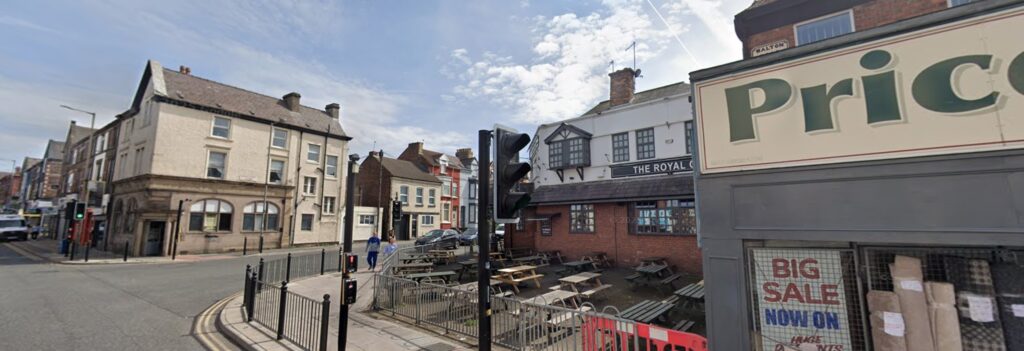
Pictured below, the final resting place of George Spink Fleming at Anfield Cemetery in Liverpool. Unfortunately, the original headstone, featuring an ornate cross in Carrara marble, fell into poor repair over the years. It was replaced in 2022 with a new stone of Indian granite, commissioned by George’s grandson, Alastair Fleming. Also pictured, the Commonwealth War Grave of Fleming’s son, Noel and the Sefton war memorial:
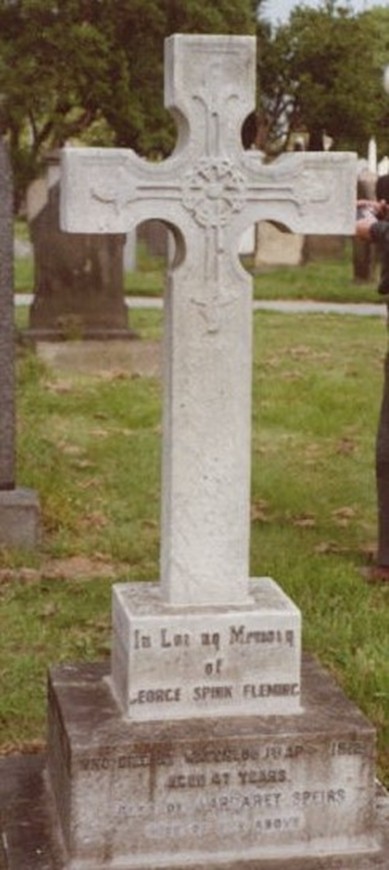
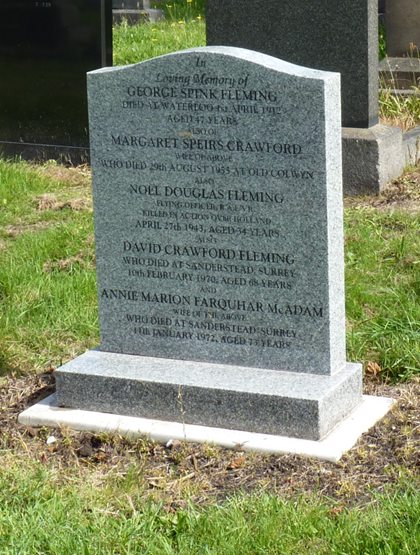
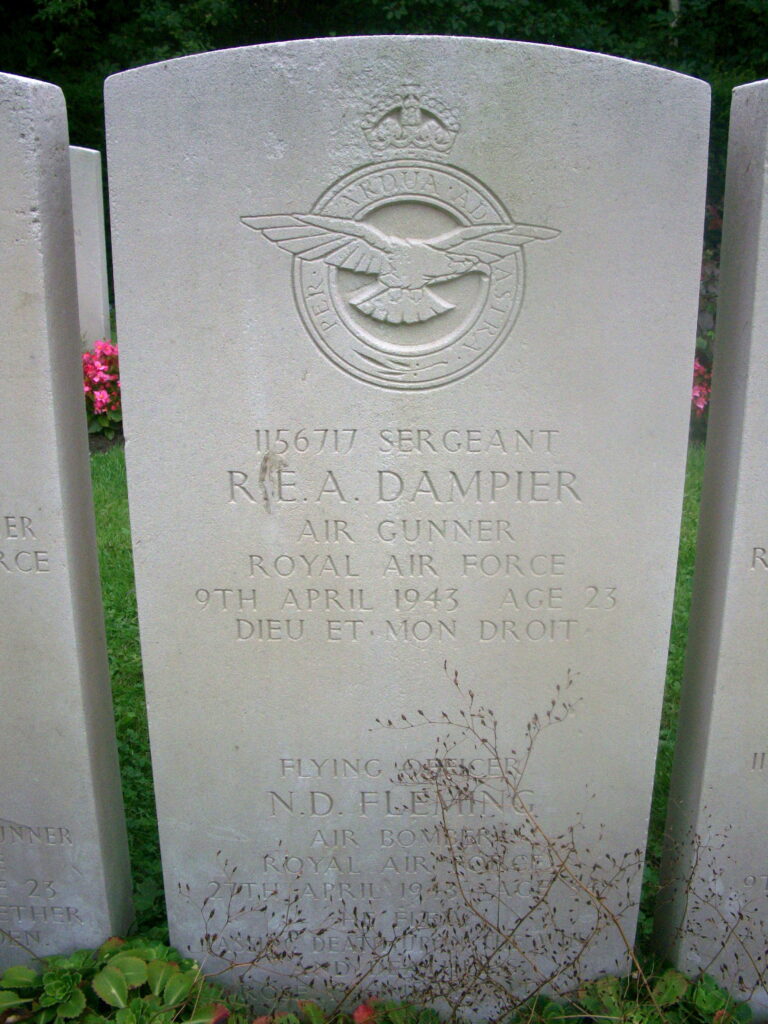

In 2016, Everton FC Heritage Society member, author and historian Tony Onslow appeared in the Perth Courier and Advertiser, discussing his research into George Fleming and his Arbroath origins.

Acknowledgements:
Tony Onslow – ‘The Goalscoring Bank Clerk From Arbroath’ (EFCHS website article)
The Everton Collection
British Newspaper Archive
www.arbroatharchive.co.uk
www.evertonresults.com
With extra special thanks to:
Mr. Alastair Fleming, grandson of George Spink Fleming
Further Notes:
George Fleming paved the way for at least three further Everton signings with Arbroath origins; William ‘Soldier’ Stewart was born in Arbroath before making his name with Distillery and Preston North End, and David Storrier and Thomas Dilly were signed by Everton directly from Arbroath.
Throughout the 1890s, an amateur team called Everton (and one called Aston Villa) competed in local football in Arbroath, possibly inspired by the town’s connection with the above players.
Between 2001-2003, Arbroath-born midfielder Darren Spink played for Arbroath. He is very likely a relative of George Fleming on his mother’s side. The Spink family remain well known fish merchants in the town, famed for their ‘Arbroath smokie’ (smoked haddock).

